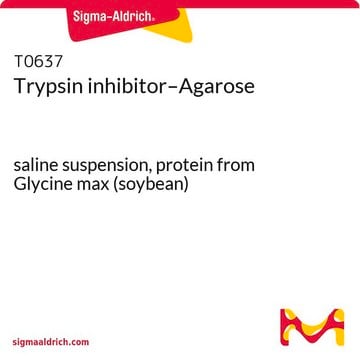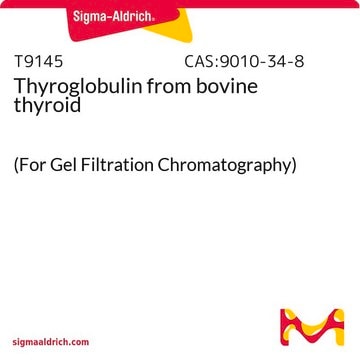10109886001
Roche
Trypsin Inhibitor
from soybean
Synonim(y):
trypsin
Zaloguj sięWyświetlanie cen organizacyjnych i kontraktowych
About This Item
Kod UNSPSC:
12352207
Polecane produkty
pochodzenie biologiczne
soybean
Poziom jakości
Postać
lyophilized
masa cząsteczkowa
Mr 20,100
opakowanie
pkg of 50 mg
producent / nazwa handlowa
Roche
stężenie
1 mg/mL
metody
cell culture | mammalian: suitable
pH
3.8-4.5
rozpuszczalność
water: soluble
temp. przechowywania
2-8°C
Powiązane kategorie
Opis ogólny
Soybean trypsin inhibitor (STI) comprises 181 amino acids. It is a monomeric protein corresponding to a molecular weight of 20 kDa and has two disulfide bridges. It belongs to serpins − serine protease inhibitors family.
Specyficzność
Soybean trypsin inhibitor is an inhibitor for trypsin, plasmin, and plasma kallikrein. It inhibits trypsin, factor Xa, plasmin, and plasma kallikrein activity in serum-free cell culture media. It does not inhibit metallo-, cysteine, aspartic proteases, or tissue kallikrein (serine proteases).
Zastosowanie
Trypsin Inhibitor from soybean is used to terminate tissue disaggregation and for subcultivation procedures.
Trypsin Inhibitor has been used:
- in the buffer for hepatocyte isolation
- to inhibit trypsin in Corneal epithelial cells
- to inhibit papain activity while treating hippocampal neural stem cells (NSCs)
Działania biochem./fizjol.
Soybean trypsin inhibitor (STI) inhibits myc proto-oncogene protein and is anticarcinogenic. It favors anti-aggregation of platelets and may be a potential protease inhibiting drug. STI inhibits renin and angiotensin.
Soybean trypsin inhibitor is an inhibitor for trypsin, plasmin, and plasma kallikrein. The product is sensitive to heat, alkaline pH, and protein-precipitating compounds.
Charakterystyka techniczna
Inhibiting activity: approximately 70 trypsin inhibitor units/mg lyophilizate at +25°C with benzoyl-L-arginine ethylester as a substrate (approximately 190 trypsin inhibitor units/mg at +25°C with Chromozym TRY as substrate)
Isoelectric point: 4.5
Isoelectric point: 4.5
Definicja jednostki
1 U = 270 S & T-units or 90 USP-units
Uwaga dotycząca przygotowania
Working concentration: 10 to 100 μg/ml
Working solution: Recommended solvent is distilled water.
Stock solution: 1 mg/ml
Storage conditions (working solution): -15 to -25 °C
The enzyme is stable for 6 months, frozen in aliquots.
Working solution: Recommended solvent is distilled water.
Stock solution: 1 mg/ml
Storage conditions (working solution): -15 to -25 °C
The enzyme is stable for 6 months, frozen in aliquots.
Rekonstytucja
Sensitive to heat, alkaline pH, and protein-precipitating compounds.
Przechowywanie i stabilność
Store at 2 to 8 °C. (Store dry!)
Inne uwagi
For life science research only. Not for use in diagnostic procedures.
Kod klasy składowania
11 - Combustible Solids
Klasa zagrożenia wodnego (WGK)
WGK 2
Temperatura zapłonu (°F)
Not applicable
Temperatura zapłonu (°C)
Not applicable
Certyfikaty analizy (CoA)
Poszukaj Certyfikaty analizy (CoA), wpisując numer partii/serii produktów. Numery serii i partii można znaleźć na etykiecie produktu po słowach „seria” lub „partia”.
Masz już ten produkt?
Dokumenty związane z niedawno zakupionymi produktami zostały zamieszczone w Bibliotece dokumentów.
Klienci oglądali również te produkty
Mice, double deficient in lysosomal serine carboxypeptidases Scpep1 and Cathepsin A develop the hyperproliferative vesicular corneal dystrophy and hypertrophic skin thickenings
Pan X, et al.
PLoS ONE, 12(2), e0172854-e0172854 (2017)
Preparation of Primary Rat Hepatocyte Spheroids Utilizing the Liquid-Overlay Technique
Kyffin JA, et al.
Current Protocols in Toxicology / Editorial Board, Mahin D. Maines (editor-in-chief) ... [Et al.], 81(1), e87-e87 (2019)
Single cell transcriptomic analysis of renal allograft rejection reveals insights into intragraft TCR clonality.
Shi, et al.
The Journal of Clinical Investigation (2023)
Isolating Taste Buds and Taste Cells from Vallate Papillae of C57BL/6J Mice for Detecting Transmitter Secretion
Anthony Y. Huang and Sandy Y. Wu
CorpBase ID (for auto-filling citation data), 6(11) (2016)
Benjamin C Orsburn et al.
Nature communications, 13(1), 7246-7246 (2022-11-27)
Single cell proteomics is a powerful tool with potential for markedly enhancing understanding of cellular processes. Here we report the development and application of multiplexed single cell proteomics using trapped ion mobility time-of-flight mass spectrometry. When employing a carrier channel
Nasz zespół naukowców ma doświadczenie we wszystkich obszarach badań, w tym w naukach przyrodniczych, materiałoznawstwie, syntezie chemicznej, chromatografii, analityce i wielu innych dziedzinach.
Skontaktuj się z zespołem ds. pomocy technicznej







